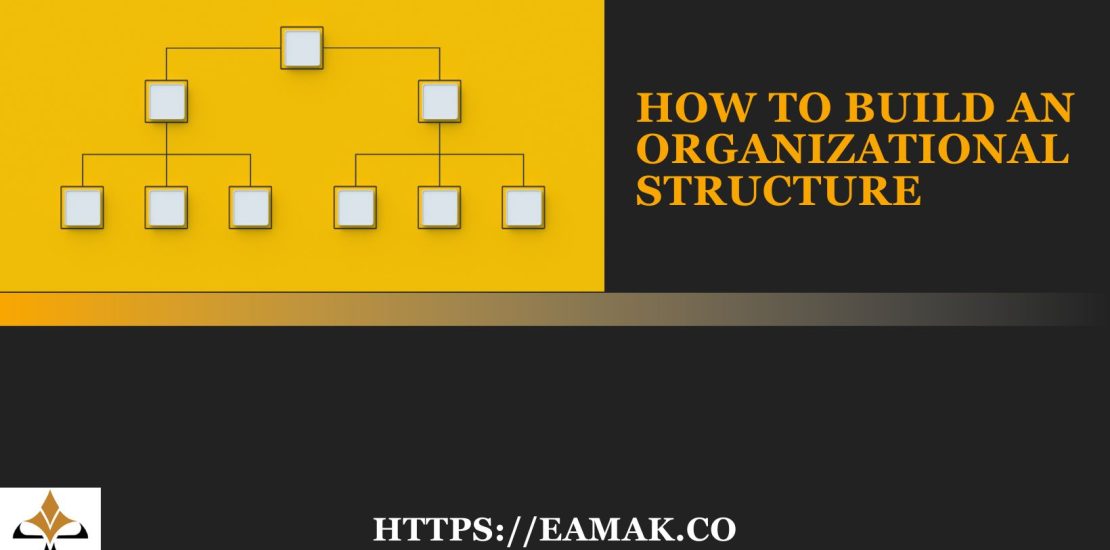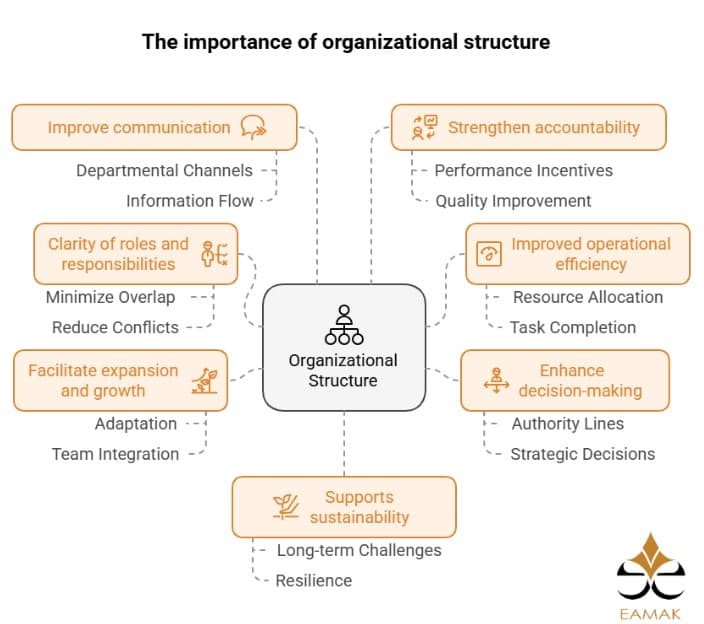How to build an Organizational Structure
- Posted by:
- Category: Uncategorized

Did you know that understanding how to build an organizational structure is pivotal to an organization’s success? In today’s fast-paced business world, creating frameworks that ensure flexibility and efficiency has become a necessity. But how to build an organizational structure that drives productivity, clarifies roles, and aligns with success criteria?
This process requires balancing clear hierarchies, seamless communication, and adaptability. In this article, we uncover the secrets to designing these frameworks transforming them into a strategic pillar for achieving goals, whether for agile startups or established enterprises.
1- Definition of Organizational Structures
Have you ever wondered how large organizations run smoothly? The answer lies in organizational structures, which are the basic map for organizing work and defining roles within any entity.
Here is a detailed definition of organizational structures:
- Definition of organizational structures: A system that clarifies the distribution of tasks and responsibilities between individuals and departments and defines lines of authority and accountability.
- Its main goal: ensuring operational efficiency, avoiding overlapping roles, and achieving coordination between teams.
- Its main elements: Includes hierarchy, job descriptions, communication channels, and decision-making mechanisms.
- Their types: It varies between hierarchical, flat, matrix, and other structures, depending on the size of the organization and the nature of its work.
- Their importance: Without a clear organizational structure, organizations lose their direction and become prone to chaos and low productivity.
2- Components of the organizational structure
Did you know that the success of any organization depends largely on the clarity of the components of the organizational structure?
This structure is not just a paper map, but an integrated system that defines how to manage resources and achieve goals.
Here are the components of the organizational structure:
- Hierarchy: defines the levels of authority and responsibility from top management to field employees.
- Division of departments: Distributes tasks to specialized units such as finance, marketing, and human resources.
- Job descriptions: Clarify the tasks and skills required for each role to ensure there is no overlap.
- Communication channels: formalized mechanisms for sharing information between teams and departments.
- Decision-making mechanisms: Determine who has the authority to approve plans and projects.
- Policies and procedures: Rules that organize daily work and ensure consistency in performance.
- Physical or digital structure: Integrating technology into process management to increase efficiency.
3- Types of Organizational Structures
 Did you know that choosing the right types of organizational structure can determine the success of your organization?
Did you know that choosing the right types of organizational structure can determine the success of your organization?
There are different types of organizational structures depending on the company’s goals, size, and nature of the business.
Here are the most common types of organizational structures that you can rely on to build a structure that suits your needs:
- Hierarchical (traditional): Based on a clear chain of authority from top management to employees, with departments divided vertically.
- Flat (horizontal) structure: minimizes layers of management to promote direct communication and empower employees to make decisions.
- Matrix structure: Combines functional specialization (e.g., marketing, finance) with project management, with employees working under dual leadership.
- Team-based structure: Work is organized around multidisciplinary teams working on specific goals, with less emphasis on hierarchy.
- Sectoral (divisional) structure: organized according to products, geographies, or types of customers, with each department having its own management.
- Network structure: Relies on a network of external relationships with partners or contractors, with limited internal focus.
- Circular structure: Focuses on cross-team collaboration with centralized leadership but with less rigid boundaries between roles.
4- The importance of organizational structure
 The importance of organizational structure lies at the heart of every successful enterprise, but why is it deemed the cornerstone of achievement? Simply put, it acts as the compass that aligns teams, clarifies responsibilities, and directs collective efforts toward shared objectives. Delving into the importance of the organizational structure reveals how it prevents chaos, enhances decision-making, and scales operations effectively.
The importance of organizational structure lies at the heart of every successful enterprise, but why is it deemed the cornerstone of achievement? Simply put, it acts as the compass that aligns teams, clarifies responsibilities, and directs collective efforts toward shared objectives. Delving into the importance of the organizational structure reveals how it prevents chaos, enhances decision-making, and scales operations effectively.
Below are the key reasons this framework remains indispensable, ensuring resilience and growth for organizations of all sizes:.
- Clarity of roles and responsibilities: It defines each individual’s exact duties, minimizing overlap and internal conflicts.
- Improved operational efficiency: organizes processes and speeds up the completion of tasks by optimizing the allocation of resources.
- Enhance decision-making: clarifies lines of authority, making it easier to make strategic decisions.
- Facilitate expansion and growth: Helps organizations adapt to changes and easily integrate new teams or departments.
- Improve communication: Establishes clear communication channels between departments to ensure information flows smoothly.
- Strengthen accountability: Holds everyone accountable for the results of their work, incentivizing performance and raising quality.
- Supports sustainability: contributes to building an organization that is able to face long-term challenges.
5- Organizational Structure Characteristics
Organizational Structure Characteristics are the defining factors in how effectively a company achieves its objectives. While no two frameworks are identical, successful ones share critical traits like role clarity and adaptable decision-making channels.
Below, we outline the most vital organizational structure characteristics, from hierarchy design to cross-departmental collaboration, that ensure alignment with strategic goals and operational excellence:
- Clarity: Roles and responsibilities are clearly defined, preventing overlap between tasks.
- Flexibility: Can be adjusted according to growth requirements or market changes.
- Defined hierarchy: clarifies lines of authority and subordination in an organized manner.
- Balance between centralization and decentralization: balances the authority of top management with the empowerment of sub-teams.
- Effective communication channels: Ensures unhindered flow of information between all levels.
- Adapts to the organizational culture: Reflects the company’s values and work style.
- Accountability: Ties each individual or department to specific, measurable results.
- Technological integration: supports the use of digital tools to optimize processes.
6- Improve the organizational structure
Improve the organizational structure: does your current framework stifle growth rather than fuel it? Far from a luxury, refining this backbone is essential to unlocking efficiency and meeting modern challenges. Improve the organizational structure by addressing misaligned roles, communication silos, or rigid hierarchies that slow progress.
Below are actionable strategies to revitalize workflows, empower teams, and align your company’s design with its strategic vision:
- Analyze the current situation: Assess the strengths and weaknesses of the current organizational structure, such as administrative complexity or overlapping tasks.
- Set goals: Set clear goals such as increasing flexibility or improving communication between teams.
- Redistribute roles: Clarify responsibilities and recruit the right competencies for each role to ensure optimal utilization of human resources.
- Simplify procedures: reduce bureaucracy and streamline complex processes to increase the speed at which tasks can be accomplished.
- Leverage technology: integrate digital tools to manage tasks and track performance effectively and quickly.
- Team training: Develop the skills of employees to keep up with new technological changes in the organizational structure.
- Continuous assessment: Periodically review the structure to ensure its relevance to internal and external changes.
Conclusion
Organizational structures are the soul of the organization that determines its success or failure.
From their definition and components to their types and ways to improve them, building an effective organizational structure is an investment in the future that promotes efficiency, clarity of roles, and flexibility to adapt to challenges.
Whether you’re running a startup or an established organization, understanding the characteristics of the right organizational structure is key to achieving your strategic goals.
If you are looking to design or improve your company’s organizational structure or need expert advice to ensure you get off to the right start, don’t hesitate to reach out to Eamak. Our expert team offers solutions tailored to your business needs to help you build a strong and competitive organization.
Find out more by visiting Eamak and make your organizational structure a foundation for long-term success.

